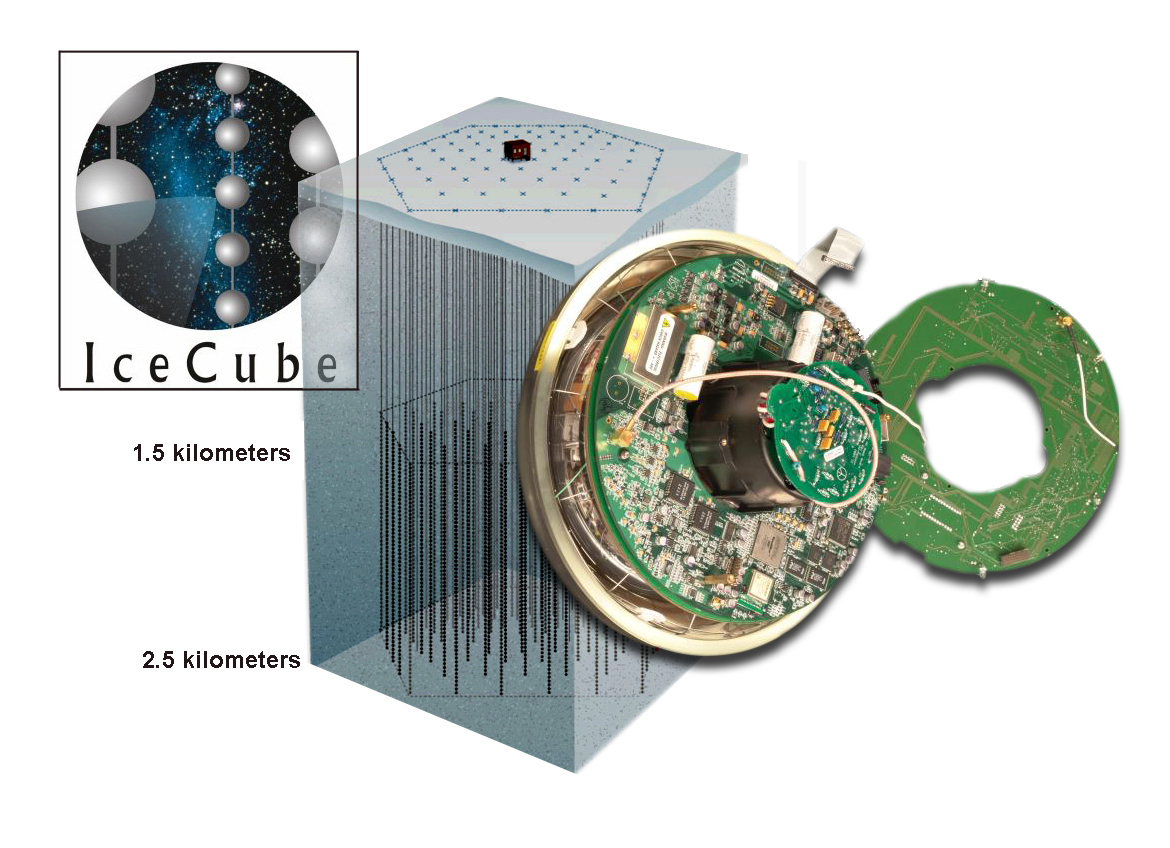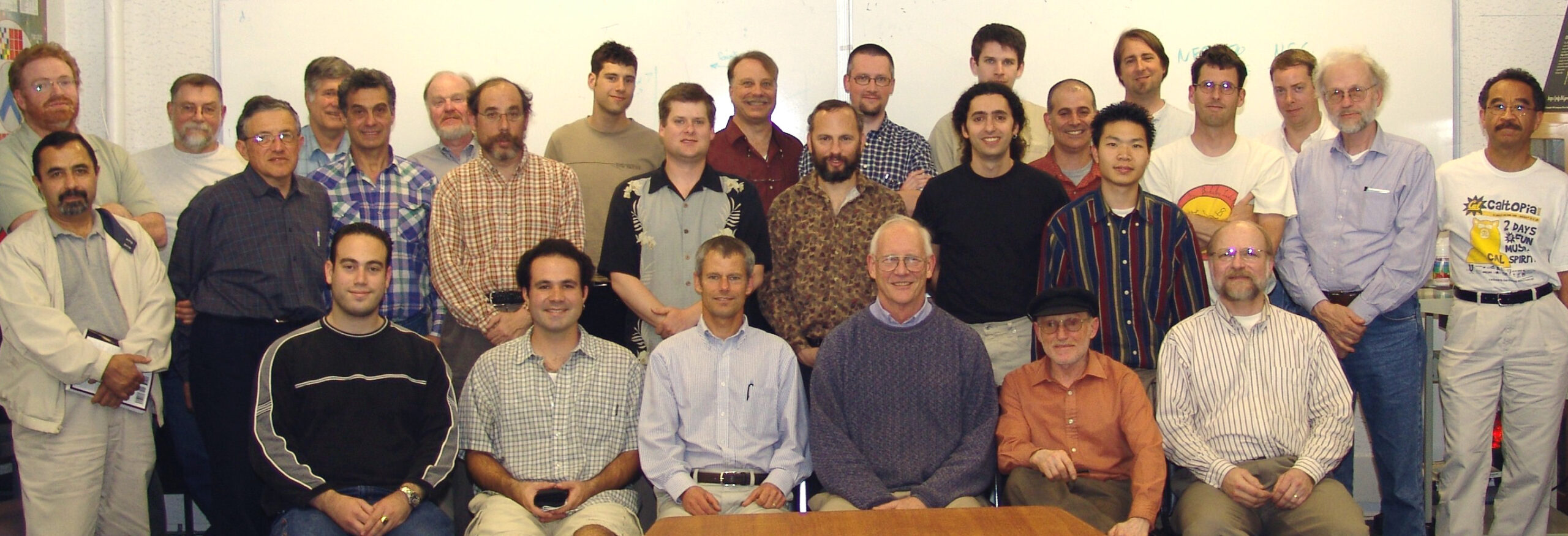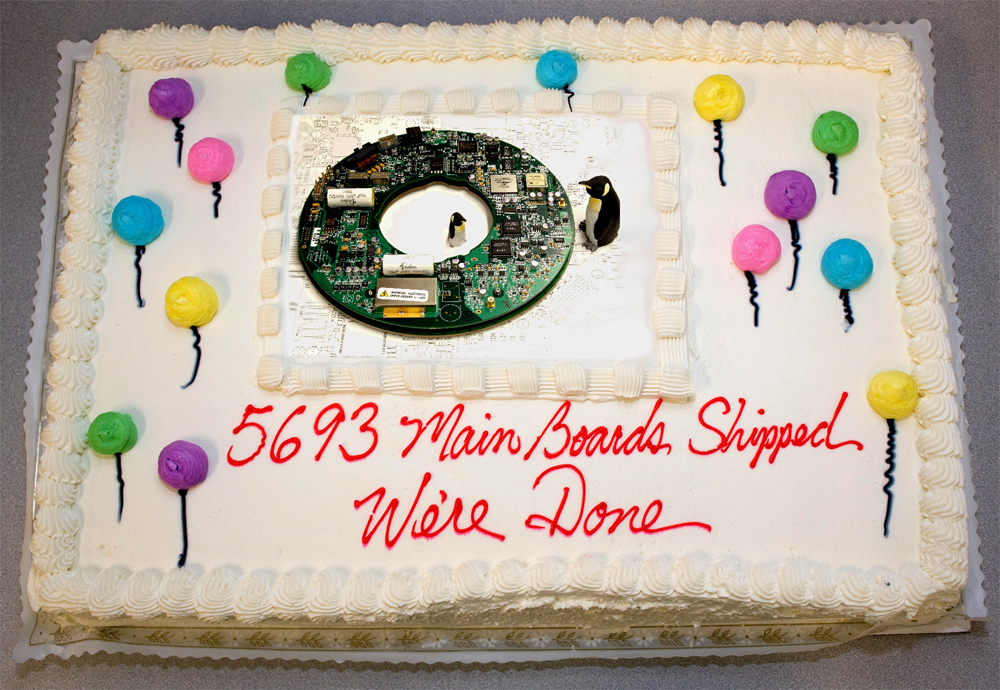Not long after the 2007-2008 South Pole summer drilling season came to an end, members of Berkeley Lab’s IceCube Project — over 30 scientists and engineers from six divisions including Nuclear Science, Engineering, Physics, Computational Research, Information Technology, and the National Energy Research Scientific Computing (NERSC) Center — met to celebrate the completion of the “main boards,” 5,693 in all, that are key components of the unique IceCube observatory. IceCube is the giant neutrino telescope now being constructed deep beneath the Antarctic ice.
Main boards are self-contained data-acquisition electronics systems carried inside each of the 60 Digital Optical Modules (DOMs) that are suspended on IceCube’s cables, or “strings,” which reach as deep as 2,450 meters (one and a half miles) down into the thick, extraordinarily clear ice that overlies the South Pole.
When completed, IceCube will consist of some 80 strings suspended in holes drilled in the ice by hot water and spaced over a square kilometer of surface area. The 60 DOMs carried by each string are suspended at intervals between 1,450 and 2,450 meters deep; thus the detector’s total volume is a cubic kilometer of ice. Each basketball-sized, clear-glass DOM contains a photomultiplier tube to detect flashes of Cherenkov radiation emitted by particles moving at faster than the speed of light in ice.
The DOMs register signals caused by various events, including spurious signals and background noise, but those of primary interest to IceCube scientists are muons from energetic neutrinos that have traveled all the way through the earth — and thus are traveling upward through the detector. The job of the main-board electronics in each DOM is to choose the signals from these — and other events of interest (for example, the appearance of exotic dark matter particles, or even miniature black holes) — from among millions of others, and from ubiquitous noise. Main-board components slice the output of the photomultiplier tube into segments of a few nanoseconds, each marked by a time stamp. If other modules nearby on the string record similar pulses within a microsecond, the pulse is considered genuine, and after further processing it is transmitted up the cable to the surface.

Digital Optical Modules (DOMs) detect flashes in the ice that signal the passage of cosmic neutrinos and other particles. IceCube’s network of detectors can track such particles back to their place of origin in the sky.
Berkeley Lab researchers pioneered the DOM technology, including the main boards, beginning in the mid-1990s; in 2001, after rigorous tests, IceCube’s collaborating organizations, led by the University of Wisconsin, chose the DOM technology over competing designs.
To date 2,560 modules have been deployed at the South Pole, with 99 percent of these meeting or exceeding specifications. The specs are stringent, considering that, once lowered into the ice and sealed in place when the water in the hole freezes, they are utterly inaccessible. In fact, the DOMs will not see daylight again until the moving ice sheet carries them all the way across the continent to the ocean, some 25,000 years in the future. With 40 strings already in the ice, IceCube is now half finished and on schedule for completion in 2010. Eighteen strings of DOMs were installed during the mid-October to mid-February Antarctic summer drilling season just ended.

Berkeley Lab’s IceCube contingent as of 2006. Front row from left, Michael Harris, Billy Robbins, Bill Edwards, Bob Stokstad, Mike Solarz, and Jerry Przybylski; middle row, Akbar Mokhtarani, Ed Kujawski, Joshua Sopher, Howard Matis, Martin Stoufer, Spencer Klein, Azriel Goldschmidt, George Chao, Arthur Jones, Dave Nygren, Jimmie Johnson; back row, Simon Patton, Chris Day, John Wolf, Chuck McParland, (unidentified), Brad Bingham, Tom McCauley, Dima Chirkin, John Joseph, Keith Beattie, and David Hayes. Not pictured, Thorsten Stezelberger and Chinh Vu.
Almost three dozen Berkeley Lab “IceCubers” have been involved with the design and construction of IceCube’s DOMs. Robert Stokstad of the Nuclear Science Division (NSD) is the project director, John Joseph of Engineering is the project manager, and Bill Edwards of Engineering was the former project manager. The ability to digitize a torrent of data within each DOM was made possible by a custom data-processing chip developed in the 1990s by Stuart Kleinfelder, then of the Engineering Division. The DOMs’ principal designers were Engineering’s Jozsef Ludvig, no longer at Berkeley Lab, and Bob Minor, retired; designers included Engineering’s Thorsten Stezelberger and Jerry Przybylski of Physics. Production was directed by Joseph, Przybylski, and Azriel Goldschmidt of NSD. Members of the Information Technologies, National Energy Research Scientific Computing (NERSC) Center, and Computational Research Divisions, including Chris Day, Keith Beatty, and Simon Patton, played key roles in designing the software for the DOM technology.
Spencer Klein of NSD heads the physics analysis team for Berkeley Lab’s IceCube participation. Even though IceCube is only half done, it has been doing science since deployment of the first sensors. “We’re looking forward to announcing important physics results to the world at this summer’s conference,” Klein says.
Additional Information
- More about IceCube
- More about IceCube’s first recorded neutrino events
- More about Berkeley Lab’s participation in IceCube
- More about Berkeley Lab’s collaboration in IceCube
- More about Berkeley Lab’s early efforts in neutrino research
